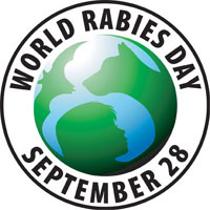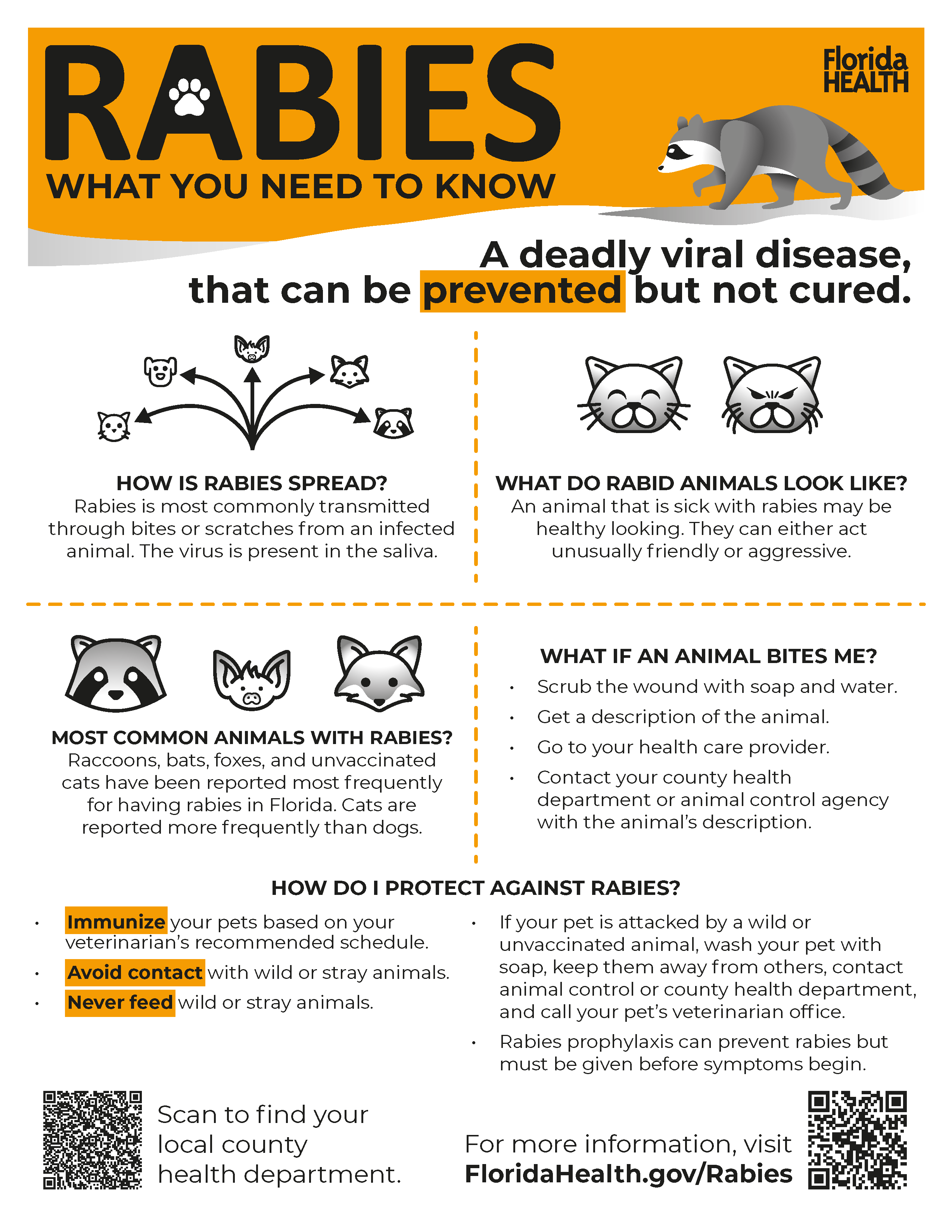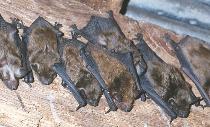It's a New Day in Public Health.
The Florida Department of Health works to protect, promote, and improve the health of all people in Florida through integrated state, county, and community efforts.
Rabies
Additional Resources
Rabies virus is very deadly, with nearly 100% fatal illness in humans and other mammals.
The virus is present in some wildlife in Florida and can spread to unvaccinated pets, which then pose a high risk to the pet owner and their family. The main wildlife sources of rabies in Florida are raccoons and bats. Infected raccoons and bats can expose people, pets, livestock, and other wildlife to rabies, typically through bites.
Outside cats are by far the most common domestic animal found to have rabies in Florida largely because they are often not kept up-to-date on rabies vaccinations. Dogs, cats, and ferrets are required by law to be vaccinated against rabies in Florida.
Exposure to Rabies
If you believe you may have been exposed to rabies, contact your health care provider and your county health department right away. If an exposure occurred, there is effective treatment that can prevent infections in people if administered in a timely manner.
- RABIES PREVENTION
- Frequently Asked Questions
- Rabies in Bats
- World Rabies Day
1. Avoid direct human and domestic animal contact with wild animals.
2. Have your veterinarian vaccinate pets and at-risk livestock, make sure you follow your veterinarian's instructions for revaccination.
3. Do not allow your pets to run free. Follow leash laws by keeping pets and livestock secured on your property.
4. Never feed wild or stray animals-avoid attracting them with outdoors food sources. Feed your pets indoors.
5. If your animal is attacked by a wild, stray or unvaccinated animal, DO NOT examine your pet for injuries without wearing gloves. DO wash your pet with soap and water to remove saliva from the attacking animal. DO NOT let your animal come into contact with other animals or people until the situation can be handled by animal control or county health department staff.
6. Educate the public to reduce contact with stray and feral animals.
7. Support animal control in efforts to reduce feral and stray animal populations.
8. Provide pre-exposure prophylaxis for people in high-risk professions, such as animal control and veterinary personnel, laboratory workers, and those working with wildlife.
9. Bat-proof homes.
How is rabies spread?
When an animal is sick with rabies, the virus is shed in the saliva and can be passed to another animal or a person, usually through a bite. Transmission may also occur if this saliva or the animal's nervous tissue enters open wounds, the mouth, nose, or eyes of another animal or person.
What do rabid animals look like?
Animals with rabies may show strange behavior -- they can be aggressive, attacking for no apparent reason, or act very tame (especially wild animals). They may not be able to eat, drink or swallow. They may drool because they are unable to swallow their saliva. They may stagger or become paralyzed. Eventually they will die.
What do I do if an animal bites me?
- Immediately scrub the wound with lots of soap and running water for five to ten minutes.
- Try to get a complete description of the animal and determine where it is so that it can be contained by animal control for quarantine or rabies testing.
- Go to your health care provider or the nearest emergency room.
- Call your local county health department or animal control agency with the description and location of the animal. The animal will either be quarantined for ten days (if it is a dog, cat, or ferret) or be tested for rabies.
- If the animal is deceased, be careful not to damage the head, and avoid further contact.
What do I do to protect myself, family, and pets from rabies?
- Have your veterinarian vaccinate all of your dogs, cats, ferrets, and horses against rabies, and make sure you follow your veterinarian's instructions for revaccination.
- Avoid contact with wild or stray animals.
- Never feed wild or stray animals and avoid attracting them with outdoor food sources (like uncovered trash). Feed your household pets indoors.
- Do not allow your pets to run free. Follow leash laws by keeping household pets under your control and livestock secured on your property.
- If your animal is attacked by a wild, stray, or unvaccinated animal, DO NOT examine your pet for injuries without wearing gloves. Wash your pet with soap and water to remove any saliva from the attacking animal. Do not let your animal come into contact with other animals or people until the situation can be dealt with by animal control or county health department staff.

September 28 is World Rabies Day. Established in 2007, World Rabies Day aims to raise awareness about the world’s deadliest infectious disease and help the world come together to fight the disease.
In the U.S., rabies deaths in people are very rare thanks to successful animal control and vaccination programs, and a robust healthcare structure that can provide rabies vaccines to people shortly after they have contact with a possibly rabid animal.
- Visit World Rabies Day for more information.





Connect with DOH